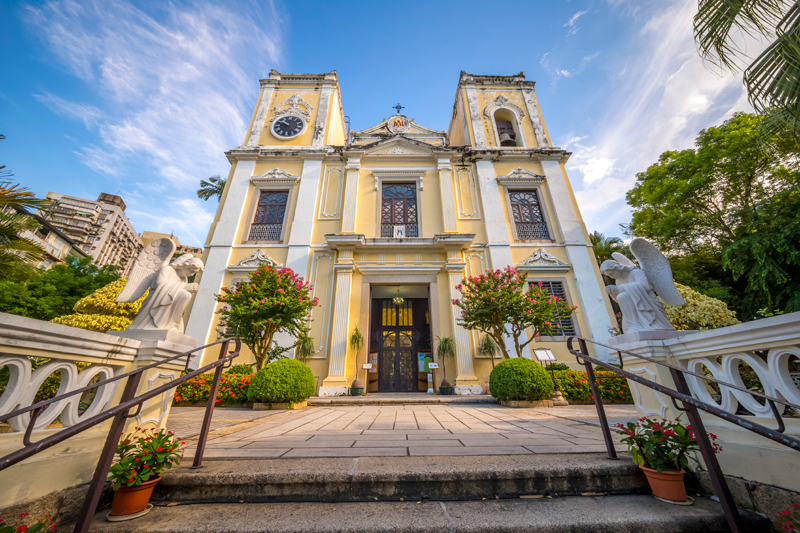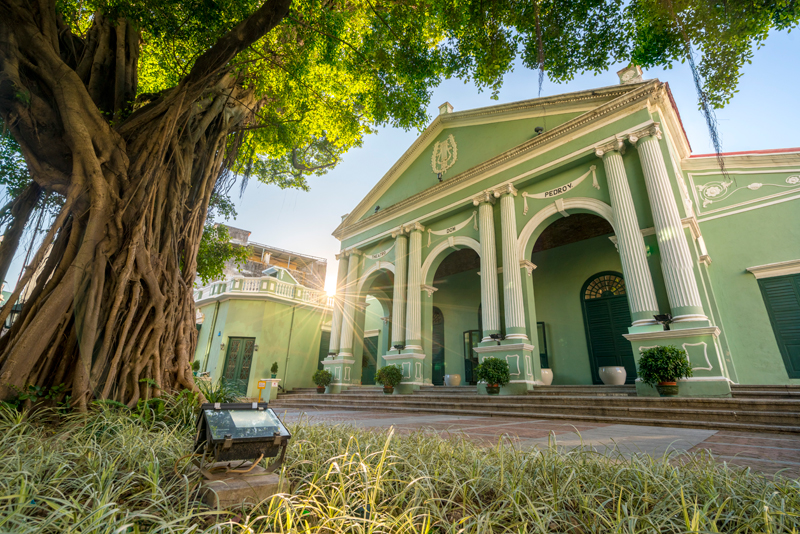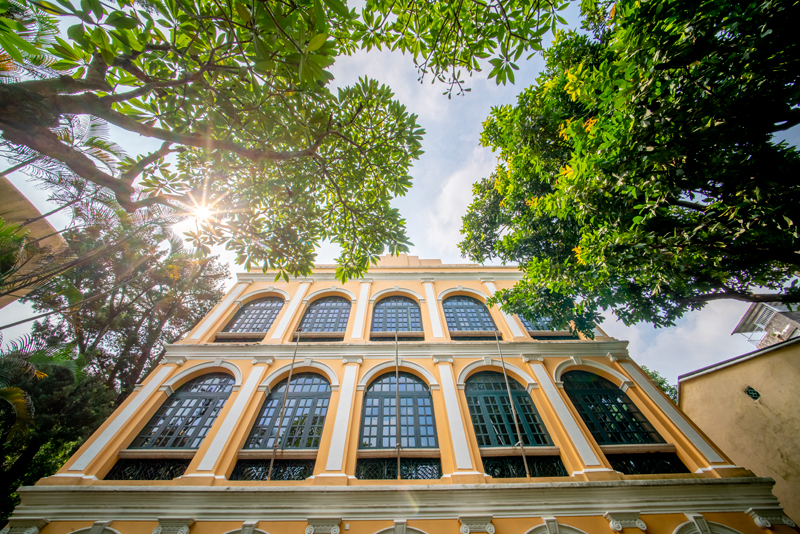Sightseeing
Explore Macao’s history and heritage at over 20 monuments in “The Historic Centre of Macao”, which was inscribed on the UNESCO’s World Heritage List in 2005.
1. Ruins of St. Paul’s
The Ruins of St. Paul's is the façade of the Church of St. Paul (also known as “Mater Dei”), which was a wooden structure destroyed in a fire accident in 1835, and the ruins of St. Paul's College, which stood adjacent to the Church. As a whole, the old Church of Mater Dei, St. Paul's College and Mount Fortress were all Jesuit’s constructions and formed what perceived as Macao's "Acropolis".

2. St. Dominic’s Church
St. Dominic’s Church was built in 1587, which is also connected to the Brotherhood of Our Lady of the Rosary. The bell tower, at the back of the building, has been modified into a small Museum of Sacred Art, now exhibiting a collection of around 300 artifacts.

3. A-Ma Temple
A-Ma Temple already existed before the city of Macao came into being. The variety of pavilions dedicated to the worship of different deities in a single complex make A-Ma Temple an exemplary representation of Chinese culture inspired by Confucianism, Taoism, Buddhism and multiple folk beliefs.

4. Lilau Square
The ground water of Lilau used to be the main source of natural spring water in Macao. The Portuguese popular phrase: "One who drinks from Lilau never forgets Macao" expresses the locals' nostalgic attachment to Lilau Square.

5. Mandarin’s House
Built before 1869, this is the traditional Chinese residential compound home of prominent Chinese literary figure Zheng Guanying, displaying a mixture of Chinese and Western detailing.

6. Moorish Barracks
Built in 1874, this building was constructed to accommodate an Indian regiment from Goa appointed to reinforce Macao's police force. Now it serves as the headquarters of the Marine and Water Bureau.

7. St. Lawrence’s Church
Built by the Jesuits in the mid-16th century, this is one of the three oldest churches in Macao. Situated on the southern coastline of Macao overlooking the sea, families of Portuguese sailors used to gather on the front steps of the church to pray and wait for their return, hence it was given the name: Feng Shun Tang (Hall of the Soothing Winds).

8. St. Augustine’s Square
St. Augustine's Square gathers various classic buildings, such as St. Augustine's Church, Dom Pedro V Theatre, St. Joseph's Seminary and Sir Robert Ho Tung Library. The cobblestone pavement unifies the area and reflects a traditionally Portuguese streetscape.

9. Dom Pedro V Theatre
Built in 1860 as the first western-style theatre in China with a seating capacity of 300, this has survived as a highly significant cultural landmark in the context of the local Macanese community and remains a venue for important public events and celebrations.

10. St. Joseph’s Seminary and Church
Established in 1728 by St. Joseph's Seminar, who taught an academic curriculum equivalent to that of a university and in 1800 the Portuguese Queen Dona Maria I conferred on it the royal title "House of the Mission Congregation".

11. Sir Robert Ho Tung Library
This building was constructed before 1894 and was originally the residence of Dona Carolina Cunha. Hong Kong businessman Sir Robert Ho Tung purchased it in 1918, after he passed away in 1955 and in accordance with his will, the building was presented to the Macao Government for conversion into a public library. Since 1958 the library has been opened to the public.

12. St. Augustine’s Church
First established by Spanish Augustinians in 1591. In times past, during heavy rain, the priests used to reinforce the rooftop with fan palm leaves. These leaves resembled dragon's whiskers swaying in the wind, so the local citizens named it Long Song Miu (Temple of the Long-whiskered Dragon).

13. ‘Leal Senado’ Building (now known as IAM building)
Originally built in 1784, this was Macao's first municipal chamber, a function it maintains to the present. The "Leal Senado" Building is neo-classical in design and has retained all its original master walls and primary layout.

14. Senado Square
Senado Square has been Macao's urban centre for centuries, and is still the most popular venue for public events and celebrations today.

15. Sam Kai Vui Kun (Kuan Tai Temple)
This temple is located close to the old Chinese Bazaar area, the location of this Chinese construction at the heart of the main city square with its predominantly western-style architecture illustrates the harmonious co-existence of the two cultures.

16. Holy House of Mercy
Holy House of Mercy was established by the first Bishop of Macao in 1569. This institution was modelled after one of the most prominent and oldest charitable organisations in Portugal, and was responsible for founding in Macao the first western-style medical clinic and several other social welfare structures that still function to this day.

17. Cathedral
Built around 1622, the Cathedral was originally constructed with taipa (compound material consisting soil and straw). The facade is characterised by pilasters and the twin belfries that stand out on the streetscape. The exterior is clad in Shanghai plaster, giving the church a monolithic subdued appearance.

18. Lou Kau Mansion
The mansion is believed to be built in 1889.This was the home of Lou Kau, a prominent Chinese merchant who owned several imposing properties in the city.

19. Na Tcha Temple
Built in 1888, this temple is dedicated to the worship of Na Tcha. This small traditional Chinese temple stands close to the remains of the principal Jesuit enterprise of the region, presenting a dialectic of western and Chinese ideals, as one of the best examples of Macao's multicultural identity and religious freedom.
20. Section of the Old City Walls
This surviving segment of the city's defense structures, built as early as 1569, is a remnant of an early Portuguese tradition of constructing defensive walls around their port settlements. In Macao, this section bears testimony to the incorporation of local techniques and materials.

21. Mount Fortress
Built in conjunction with the Jesuits from 1617 to 1626, this was the city's principal military defense structure. The fortress was equipped with cannons, military barracks, wells and an arsenal that held sufficient ammunition and supplies to endure a siege lasting up to two years.

22. St. Anthony's Church
First built of bamboo and wood before 1560, this is one of the oldest churches in Macao, also marking the site where the Jesuits set up their earliest headquarters in the city. Previously, members of the Portuguese community would hold wedding ceremonies there, so giving rise to the Chinese name of Fa Vong Tong (Church of Flowers).

23. Casa Garden
This house was built in 1770 and was originally the residence of a wealthy Portuguese merchant, Manuel Pereira. At a later period it was rented out to the East India Company. Nowadays the property is the headquarters of the Oriental Foundation.

24. Protestant Cemetery
The Protestant Cemetery provides a comprehensive record of the earliest Protestant community of Macao. Together with the site, the chapel was built in 1821, which is now referred to as "the Morrison Chapel" in honour of Robert Morrison (1782-1834).

25. Guia Fortress (including Guia Chapel and Lighthouse)
The fortress was built between 1622 and 1638. Inside the fortress stands Guia Chapel, originally established by Clarist nuns, who resided at the site before establishing the Convent of St. Clare.
Guia Lighthouse, which also stands within the perimeter, is the first modern lighthouse on the Chinese coast. Guia Fortress, along with the chapel and lighthouse are symbols of Macao's maritime, military and missionary past.




